
E.M. Muralidharan
Senior Principal Scientist ( Retired)
Kerala Forest Research Institute &
Consultant, INBAR
Chair, Task Force on Sustainable Bamboo Management
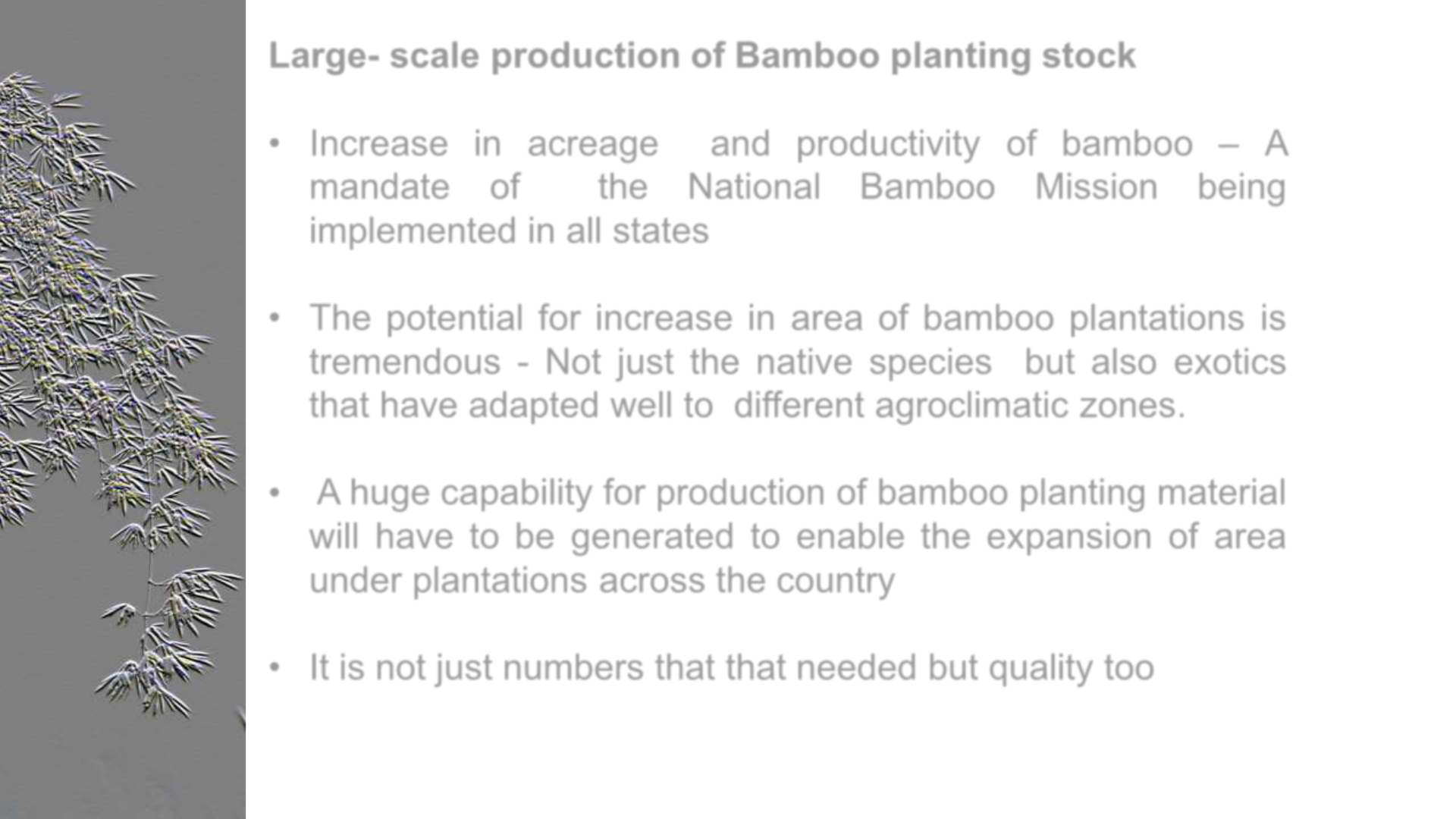
Large- scale production of Bamboo planting stock
• Increase in acreage and productivity of bamboo – A
mandate of the National Bamboo Mission being
implemented in all states
• The potential for increase in area of bamboo plantations is
tremendous - Not just the native species but also exotics
that have adapted well to different agroclimatic zones.
• A huge capability for production of bamboo planting material
will have to be generated to enable the expansion of area
under plantations across the country
• It is not just numbers that that needed but quality too

Streamlining of the mass propagation techniques
Technologies in use at present:
- Germination of seeds,
- Macro-proliferation of seedlings,
- Vegetative propagation methods : Rooted culm/branch
cuttings, Rhizome offsets, Air layering
- Micropropagation through axillary bud proliferation
Poor multiplication rates and scale of production are still
hurdles for mass multiplication in many of the important
species

Plant Tissue Culture
The technique of growing plant cells, tissues or organs under
sterile and controlled environment on a synthetic, defined
nutrient medium
Micropropagation is the application of plant tissue culture
techniques for large-scale propagation

Essentials for Tissue Culture:
• Sterile ( Microbe free ) environment
• Defined plant tissue culture medium
• Suitable tissues to initiate cultures

Tissue culture is a sterile procedure and therefore
involves work in an environment free of fungi and bacteria
Sterility has to be ensured with
i. Plant material used to start the culture (explants)
ii. The tissue culture medium and the culture vessel
iii. The area in which the cultures are transferred between
vessels

Plant Tissue Culture Medium
• A mixture of chemicals of defined composition
essential for a particular type of plant tissue culture
• Provides for the nutrient requirement of the culture
- Minerals, Vitamins, Carbon source ( sugars)
• Plant Growth Regulators (hormones)

1. Mass Clonal Propagation (Micropropagation):
- Large scale clonal propagation of superior varieties
- Propagation when conventional methods fail or are too slow.
- Production of disease free planting stock
Applications of Plant Tissue Culture

Advantages over conventional methods:
- Very high multiplication rates
- Disease free plants produced
- Production possible throughout the year
- Plant production done in a small area
- International transfer of plants without quarantine
Applications of Plant Tissue Culture

2. In Plant Improvement and Breeding
- Anther culture
- Production of somatic hybrids
- Somaclonal Variation Technology
- Production of triploids through culture of endosperm tissue
- Embryo rescue
Applications of Plant Tissue Culture

3. Genetic Engineering
- regeneration of plantlets from cells into which recombinant
DNA has been introduced
4. Basic research
- cell biology, molecular biology , gene expression studies etc
Applications of Plant Tissue Culture

MICROPROPAGATION OF BAMBOO

Advantages of Bamboo Micropropagation
-- Large scale propagation possible where alternate methods are too slow
to meet the demand
When seeds are not available, a few years after flowering
Very long flowering cycles in some species
Vegetative methods are insufficient
- Propagation of superior elite selections for genetic improvement
selected clumps with faster growth , higher yield, disease/pest resistance
can be propagated.
- Disease and pest free planting material is ensured through tissue culture
which is a sterile technique
- Centralised mass propagation facilities and easy transport of planting
material to field
Small size of plantlets

Bamboo Micropropagation
1: Surface sterilization
Nodal explants of about 2-5 cms excised, cleaned
of dead tissue, bracts. Washed with mild detergents
Surface sterilization with mercuric chloride or sodium
hypochlorite solutions of varying concentrations and for
varying durations
Rinses with sterile distilled water
under sterile conditions

One of the requirements of micropropagation is the large scale
regeneration of complete plantlets from cultured plant parts
(explants)
This is achieved in bamboo through two pathways:
1. Induction of multiple shoots through enhanced proliferation
of meristems followed by rooting of shoots
3. Induction of somatic embryos (adventitiously) followed by
their germination or conversion to plantlets

Bamboo Micropropagation
2: Initiation of cultures
Axillary bud proliferation first obtained in sterile nodal explants on a
simple nutrient medium with low levels of cytokinins especially Benzyl
Amino Purine (BAP) or Kinetin (Kin)

Bamboo Micropropagation
3: Multiplication
Shoots are multiplied on media with varying levels of cytokinins
with or without auxins ( 0.5 to 6 mg/l)
Liquid or agar solidified medium used for multiplication
Regular subcultures to fresh media every few weeks
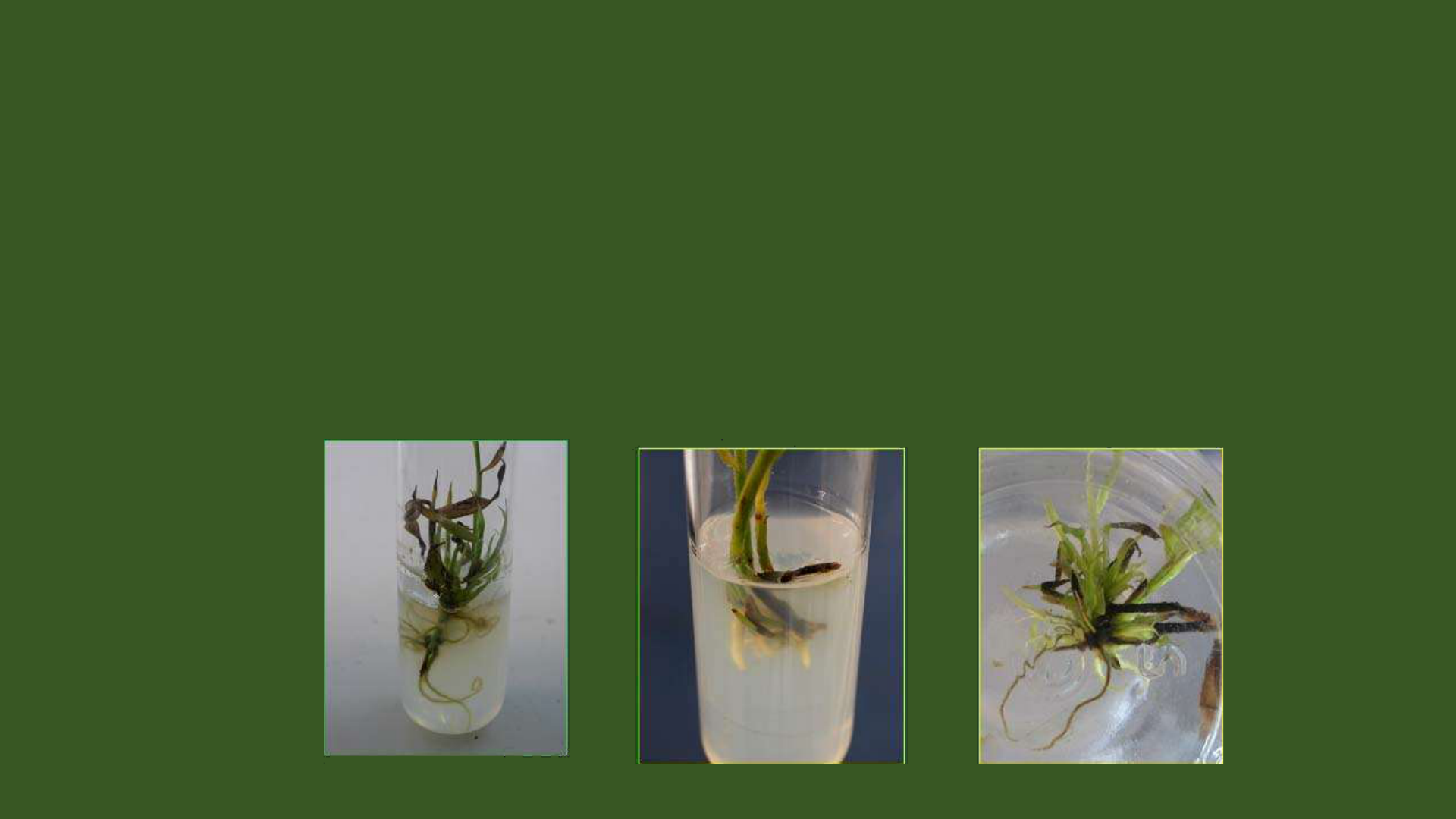
in vitro rooting
4: Rooting
Shoots can be rooted
in vitro or ex vitro
Media supplemented with auxins (NAA, IBA ) used or shoots
dipped in rooting solutions or powders
In vitro rhizome induction improves survival of plantlets
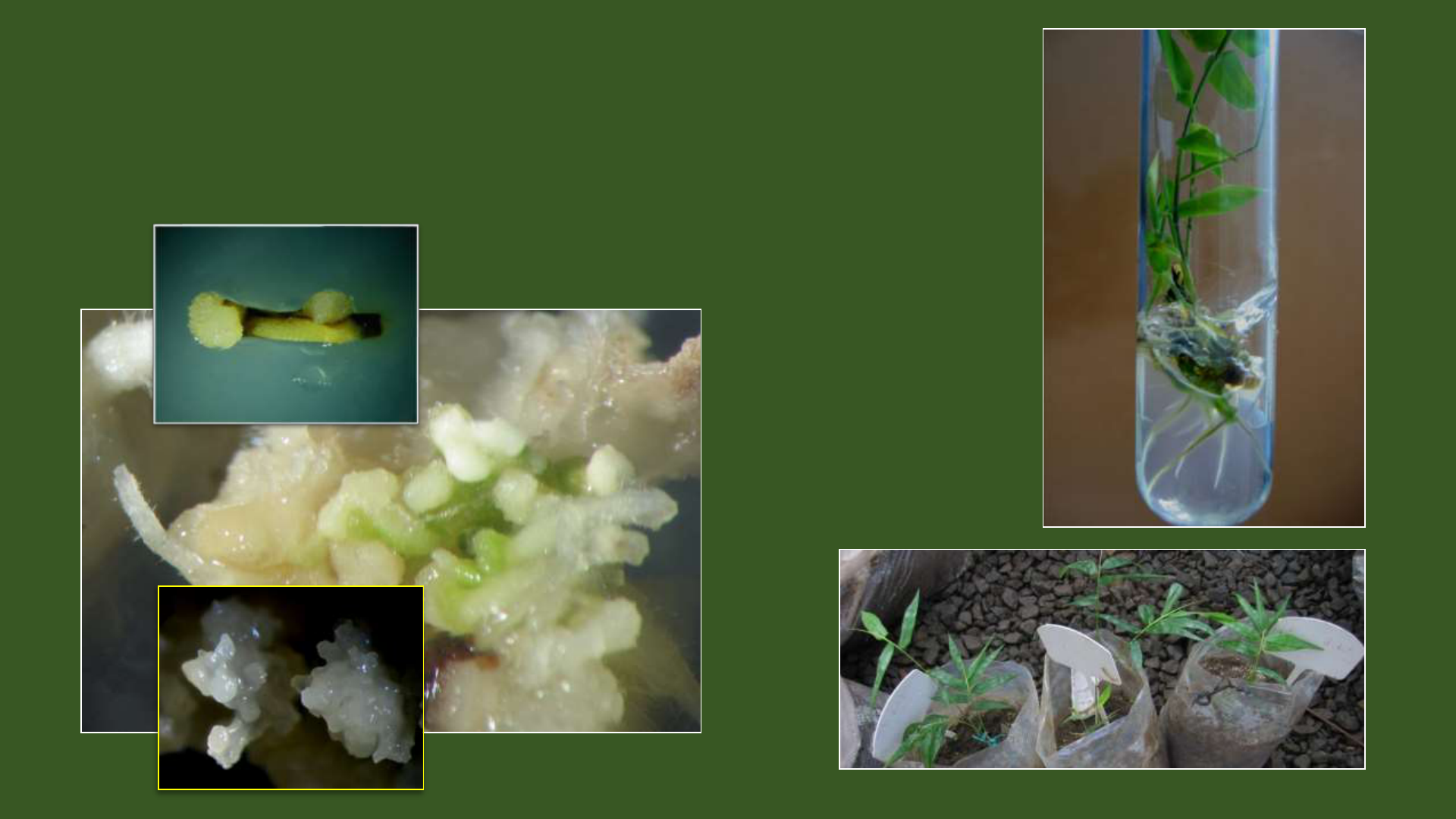
Somatic embryogenesis
in bamboo
Plantlet regeneration
Hardened plantlets
Somatic embryos

1. Bambusa balcooa Commercialised
2. B. bambos Commercialised
3. B. nutans Commercialised
4. B. polymorpha
5. B. tulda Commercialised
6. B. vulgaris Commercialised
7. Dendrocalamus asper Commercialised
8. D. brandisii
9. D. giganteus
10.D. hamiltonii
11.D. longispathus
12.D. membranaceus
13.D. strictus Commercialised
Important Commercial Species with success in Tissue culture

14. Gigantochloa atroviolacea
15. Guadua angustifolia Commercialised
16. Melocanna baccifera
17. Ochlandra travancorica
18. Pseudoxytenanthera stocksii Commercialised
19. Thyrsostachys oliverii

Large-scale production of bamboo planting material
- What are our priorities?
Quality of planting stock
- Precise Identification of species and clones
- Mass multiplication only of superior selections
- Quality of nursery planting stock
- Assurance of quality through certification
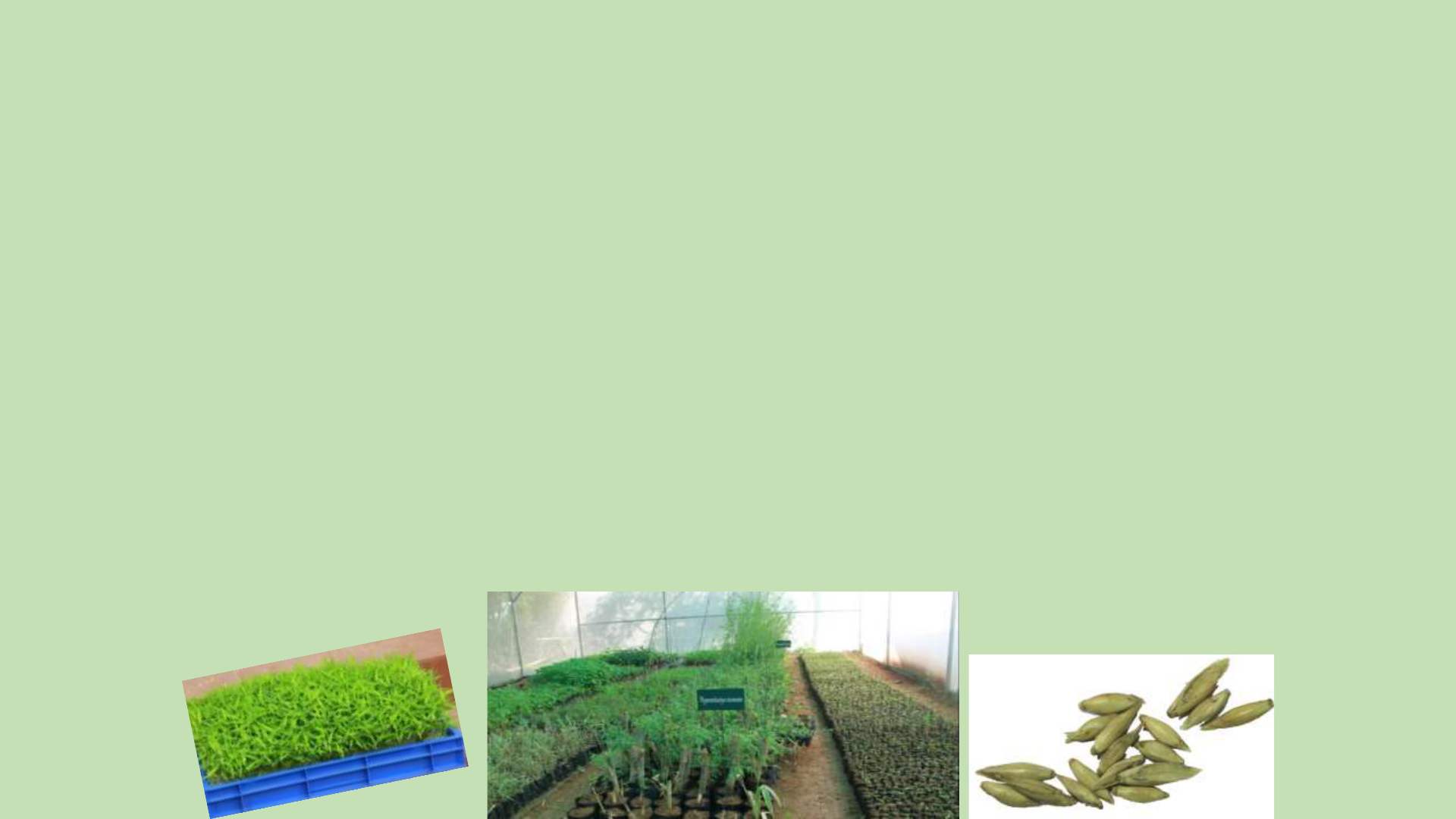
Seeds for mass propagation – Why is it not desirable?
Pros : Maintains diversity in populations and enables selection at a later stage
Year of flowering can be estimated
Cons : Untested for superiority- years before performance can be evaluated
Short viability of seeds
Unpredictable flowering cycles
Except for Bambusa bambos and Dendrocalamus strictus availability of seeds
in sufficient quantity is not assured

But what is to be propagated ?
The major issue however is the production of quality planting material vis-a-vis
the status of genetic improvement programmes in bamboo.
The biology of bamboo makes it un amenable to conventional genetic
improvement .
The solution:
- Establishment of clonal /rhizome bank of precisely identified and genetically
superior plants and
- A certification system that ensures quality control of planting material
produced through accredited bamboo nurseries.
The best option available for quality bamboo planting material for large scale
plantation programmes is:
Efficient micropropagation of superior clones selected early in
the flowering cycle

What is a superior bamboo clone?
- Productivity in biomass
- Number of culms per clump formed /surviving
- Quality in straightness and taper
- Lack of congestion in clump in clumping species ( length of rhizome neck)
- Long/Short internodes
- Absence of flowering or resumption of vegetative growth after flowering
- Known year of flowering
Selections to be done from natural and planted forests followed by multilocational
field performance testing

Certification of bamboo planting material
• Planting material produced through all the methods are available and
often plants offered for sale are of dubious origin.
• To ensure that only quality planting stock is used NBM has embarked
on a programme of certification of bamboo planting material which will
be eventually mandatory for future NBM plantations
• Complementing the certification of planting material NBM also has a
scheme for Certification of Bamboo Nurseries
• Only mother clumps identified by experts will be used for large scale
propagation. All nurseries will maintain or have access to Rhizome
bank /Clonal Garden
• All parameters of plant health and quality will have to met in a
certified Bamboo planting material

Certification of Bamboo
Planting Material & Accreditation
of Bamboo Nurseries
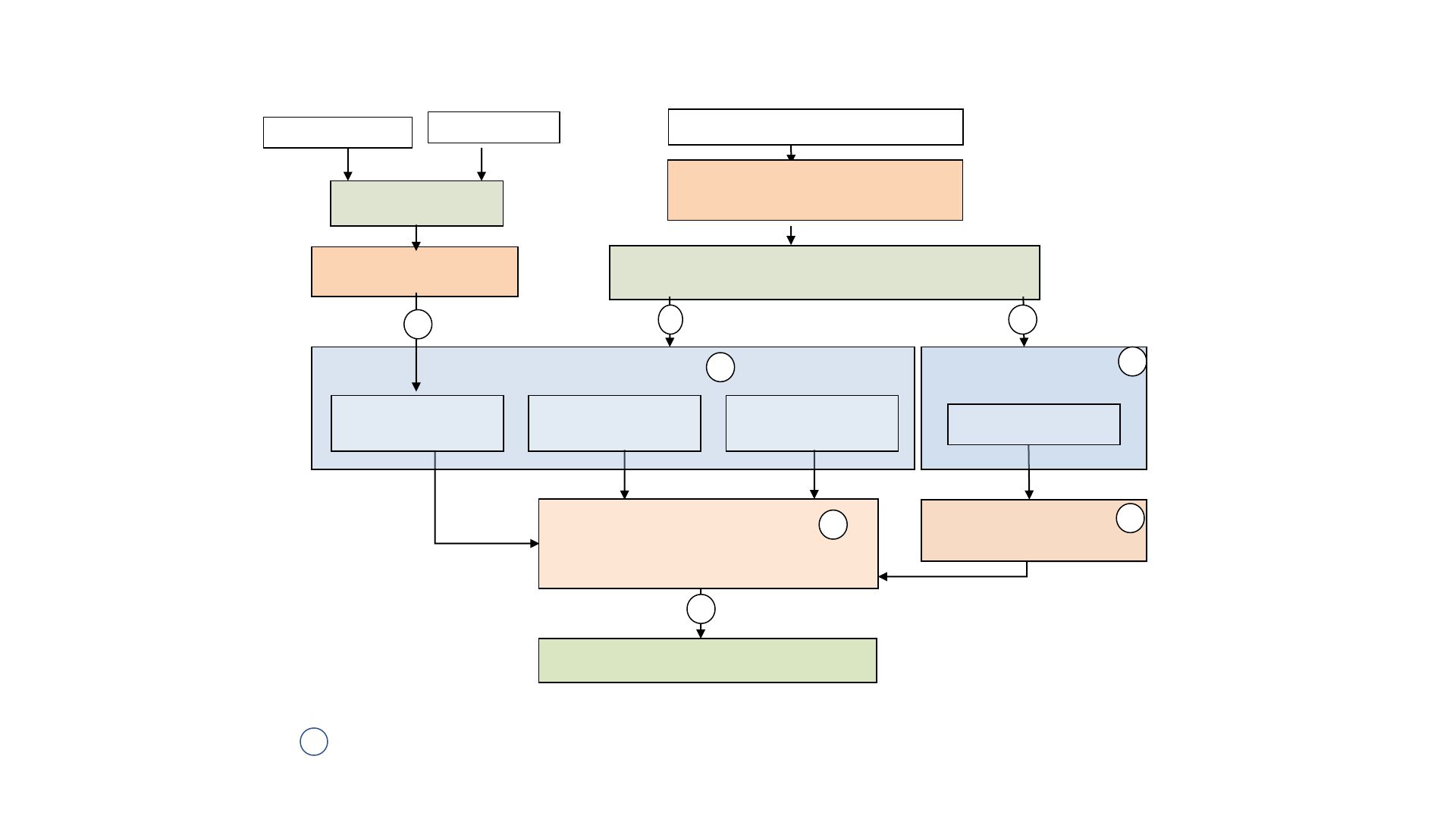
Sporadic Flowering
Species identification
(Research Institutes)
Accredited Hi-Tech Nurseries
DBT certified TC Production Facility
Micropropagation
Rhizome TransplantsCulm/ Branch cuttings
Seedlings
1
2
Bamboo Germplasm Collections
Variety Releasing Committee
ICFRE
Gregarious Flowering
National Registry of Superior
Bamboo Clones
Bamboo Seeds
33
4
Certified Bamboo Planting Material
National Certification System for Tissue
culture Plants (NCS-TCP), DBT
Accredited Certification Agencies
&
National Bamboo Certification Authority
2
6
5
Framework of the National Certification Process for Quality Planting Material in Bamboo
X - Requires Certificate for ensuring traceability through chain of custody

Certification of bamboo planting material
- Requires establishing the taxonomic and clonal identity of the planting
material available in the nurseries.
- Identification in bamboo is based on the morphological features (culm
sheath and flowers)
- Culm sheaths an important feature does not persist beyond a few
months
- The unique growth pattern and semelparous (monocarpic) flowering
imposes a hurdle in easy identification
- Other features like culm colour, diameter etc. is not dependable since it
is influenced by the environment and age of the culm

Species Identification:
• Bamboo identification in all species is difficult at all stages of growth but
especially at the juvenile stage
• In planting stock derived through seeds or clonal propagation in the
nursery simple identification procedure will help mixing up of species
Solutions:
Species identity established by taxonomists from mother clumps + meticulous
documentation ( Paper trail) up to sales outlet.
Identification based on DNA: Precise identification is feasible when DNA
barcoding technology is standardized.
Major Constraints:

Any tissue collected at any stage of growth regardless of the type of
propagation can be used or even from herbarium specimens .
DNA BARCODES
Short stretches of DNA from a prescribed region which show unique pattern
within the species but differ between species

Identification of clones:
- The use of DNA fingerprinting techniques will provide precise identification of
clones within species
- Precise identification of clones derived and traceable to superior selections of
known origin will help ensure quality of planting material and
- Avoid the risk of unpredictable gregarious flowering and death of planted bamboo
- Clonal identity is precisely established through well established DNA
fingerprinting techniques
- Use of molecular makers - ISSR and SSR

Scaling up of micropropagation
• Laboratory protocols are available for a number of species
• Commercial micropropagation is restricted to less than a dozen
• Institutional facilities and priorities not suitable to scale up protocols
• Academia – Industry collaboration in R& D needed

Intitiation Phase:
Choice of Mother plant, explant , season of collection
Juvenile vs. Mature phases
Microbial contamination
Multiplication Phase:
Latent contamination
Low Multiplication rates
in vitro flowering and death of shoots
Plantlet regeneration:
Low rooting frequencies
Poor acclimatization
Cost effectiveness:
Low efficiency of micropropagation
Constraints in Tissue culture of Bamboo

Mechanization – Use of liquid media and Multiplication in Bioreactors
• Shoots maintained upto 2 ½ months without subculture simple bioreactors
• Very high multiplication rates
• Considerable reduction in labour intensive tissue culture steps
• Scaling up is needed for commercial applications
Overcoming the constraints

Shoot multiplication in
Modified Airlift Bioreactor

• High CO2 levels
• High light intensities in the PAR range
CO2 Growth Chamber
Photoautotrophic Tissue culture
• Production costs can be upto 40 % lower
when compared to conventional
micropropagation
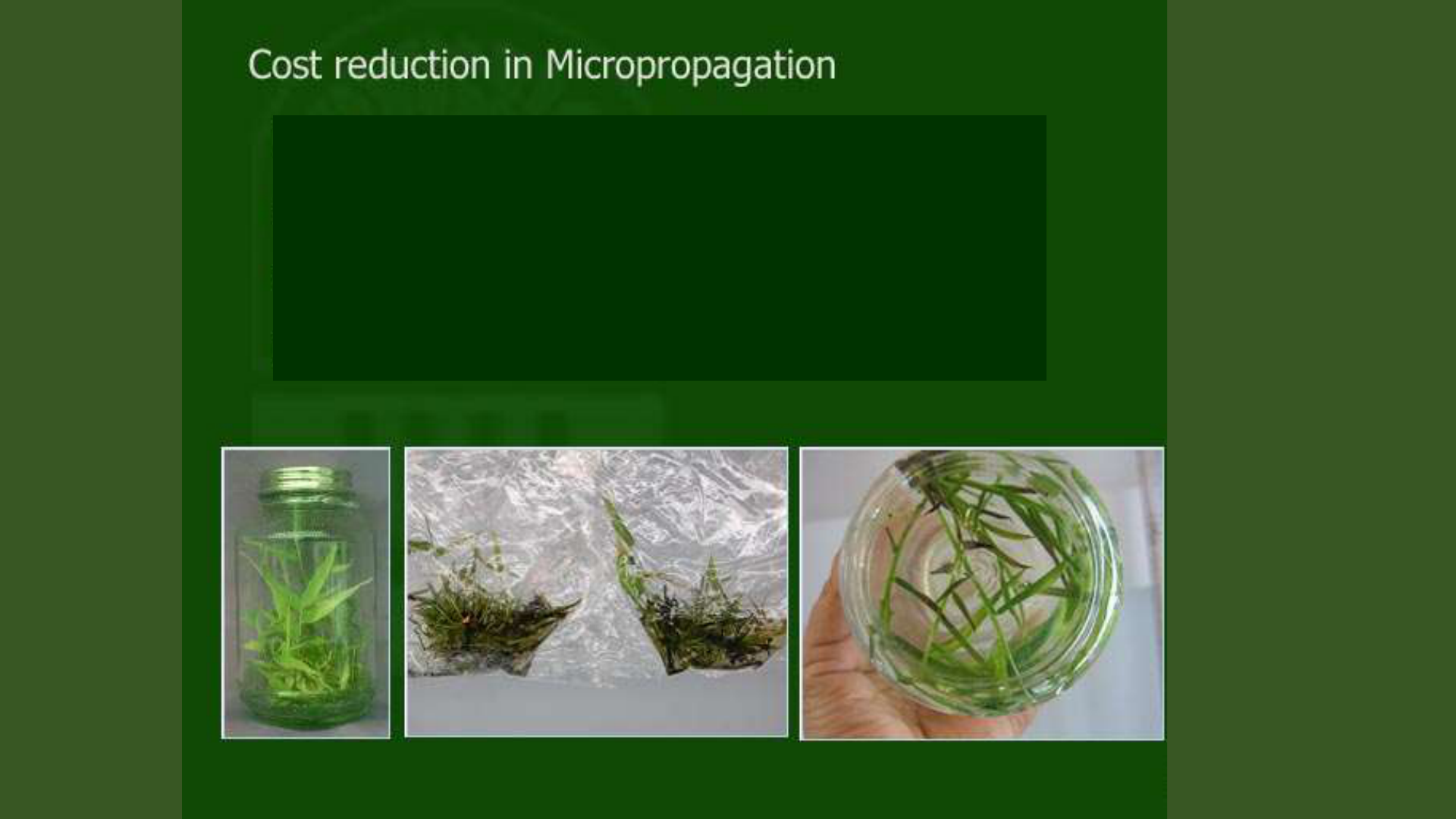
Use of liquid stationary media
Use of cheaper media components and containers
Photoautotrophic micropropagation
Use of ambient temperature and light
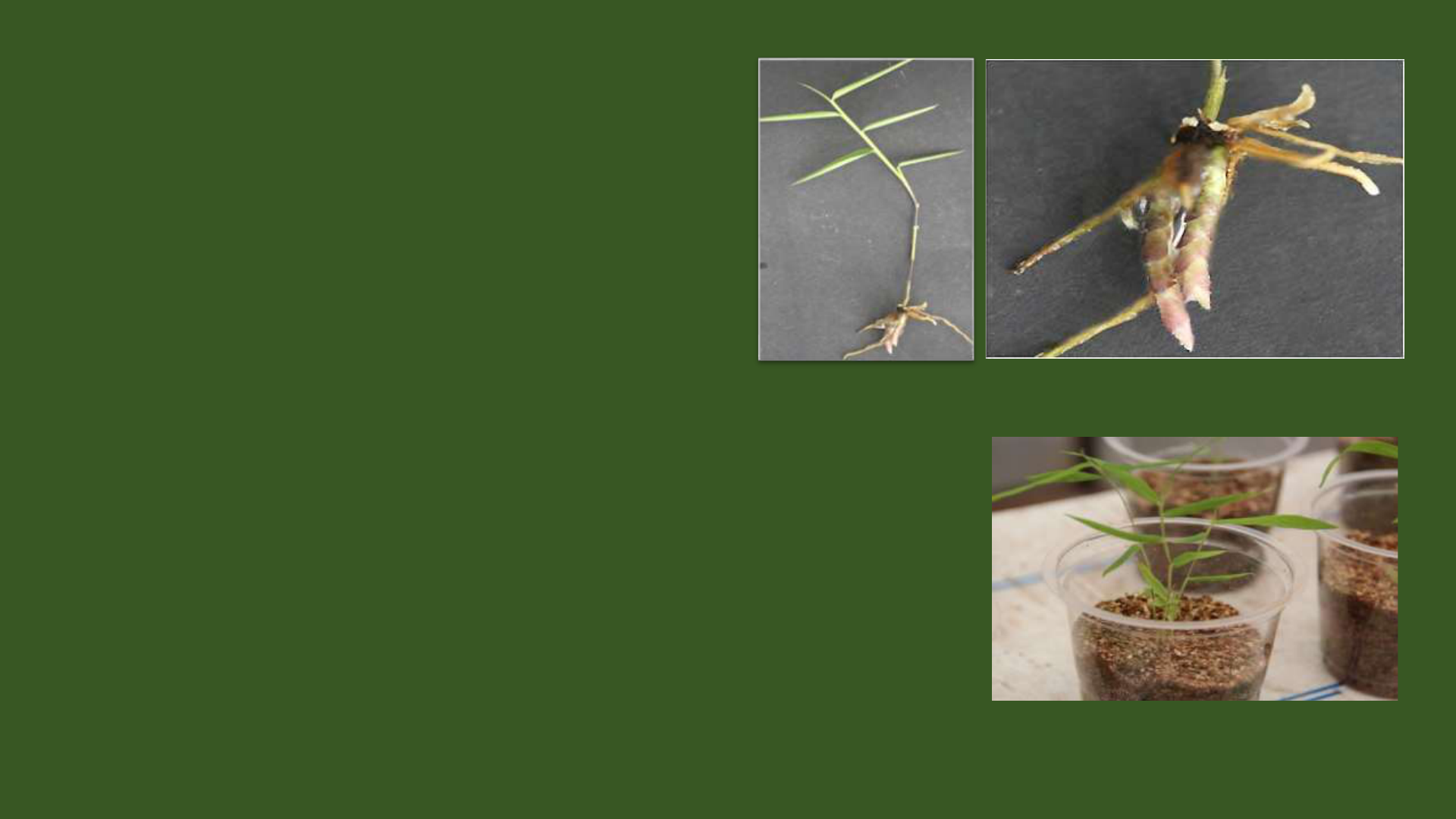
Hardened plants
In vitro Rhizome formation
In vitro Rhizome Induction
• Improved hardening of micropropagated plants
• Improved survival rates in nursery and field

Control of microbial contamination
• Improved prophylactic treatments in plants under greenhouse to obtain
clean explants
• Standardisation of novel surface sterilization treatments
• Suppression of latent microbial contaminants through biostasis

Control of in vitro flowering
• Understanding of the factors influencing in vitro flowering
• Control over plant growth regulators and culture protocol
• Reduction of stress factors in tissue culture

Conclusions
• Technical expertise, research capability in bamboo tissue
culture adequate in India
• Installed capacity for bamboo micropropagation sufficient
for the country is not difficult to achieve
• Industry – Academia collaboration for scaling-up of lab
procedures will help commercialization of additional bamboo
species
• Adoption of latest developments in techniques will be of great
benefit

Thank You
